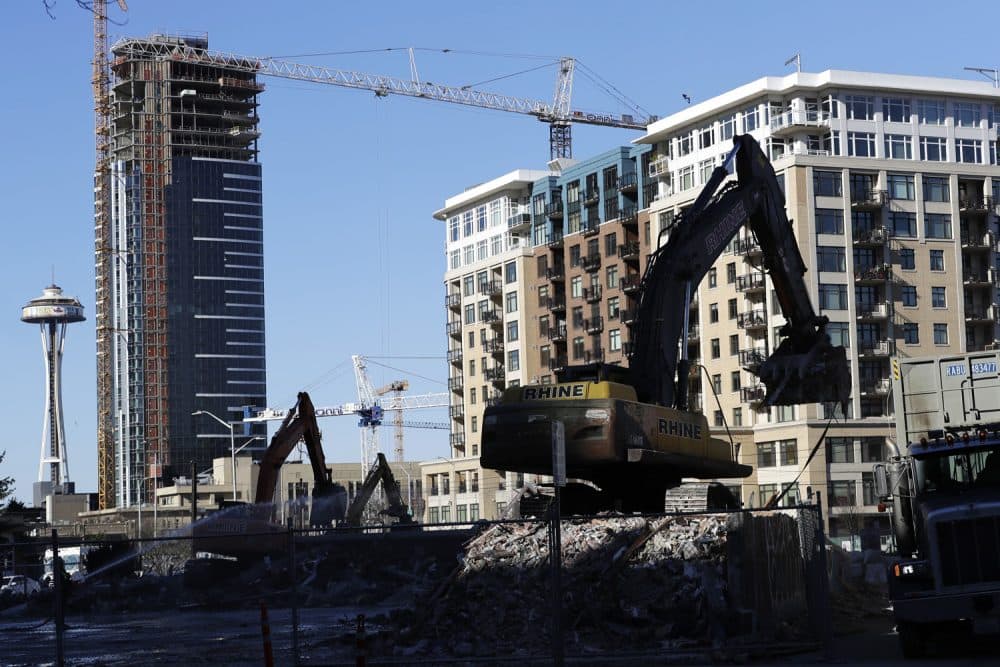Advertisement
How Did Housing Become So Expensive?
Resume
With David Folkenflik
From San Francisco, to Seattle, to San Antonio — we're looking at the crisis of affordability in the country’s hottest housing markets.
Guests:
Paul Roberts, journalist who covers technology, economics, business, and “social disruption." (@Pauledroberts)
Elizabeth Greenspan, writer and urban anthropologist who regularly covers cities, architecture and real estate for The New Yorker and ARCHITECT magazine. Lecturer at the University of Pennsylvania’s Urban Studies program and senior researcher at the School of Design. (@lizgreenspan)
Carol Galante, professor of affordable housing and urban policy, University of California – Berkeley. Faculty director of the Terner Center for Housing Innovation. (@carolgalante4)
Highlights:
On causes of the crisis:
Roberts: "[Seattle] is booming. It's a tech-fueled boom. It's bringing in lots of people, and that's bidding up the price of housing faster than a local market can deliver new supply. Basically, the housing crisis is sort of the symptom of success. It really causes people to assume that this affordability crisis is permanent — but there are other elements that aren't being surfaced yet. And those point to some of the deeper drivers but also to some of the policy solutions we should be looking at."
On why aren't there more affordable, new developments
Galante: "Part of the challenge is developers have to spend a lot of money to build these homes, and if they can't get a certain rent level, then they're not going to build it. The cost of construction and the cost of new development is extraordinarily more expensive than it was, even 10 years ago and continuing to rise rapidly. That creates this problem of only this upper end, and not housing for the vast middle class."
On what happens when expensive housing enters a city
Greenspan: "As you have more expensive housing, you have more people who can afford more expensive things and afford more expensive services. The entire city starts to orient itself towards serving that kind of clientele: groceries, high-end stores. And part of this then comes along with a certain look and feel that a lot of us probably recognize... they all kind of look the same... That sends a signal to everyone else, who doesn't have a lot of money, that this isn't really a space for them maybe. That they don't belong here. And then that gets into questions of class and race."
Tweets from our audience:
From The Reading List:
Politico Magazine: ‘My Generation Is Never Going to Have That’ - "Seattle’s red-hot tech economy, led by companies such as Amazon and Groupon (where Lubarsky works), has filled the city with an army of well-paid workers bidding up the price of housing. But that tech-fueled demand has tended to overshadow the other driver: insufficient supply. Since the end of the financial crisis, Lubarsky says, Seattle has added roughly 100,000 jobs, but barely 32,000 new homes and apartment units. 'We’ve underbuilt every year since 2010,' he adds. And a big part of that deficit, Lubarsky says, is due to neighborhoods like Wallingford, where zoning laws make it almost impossible to build anything other than a single-family house.
"Yet like so many newcomers to Seattle, Lubarsky quickly discovered that, in housing, at least, the market was actually ignoring a lot of problems. That failure was most obvious for the city’s many low-income residents, who simply couldn’t afford to pay what private developers need to profitably build housing in the city. (The Seattle area, the nation’s 22nd largest by population, has the third most homeless people, behind only Los Angeles and New York City.) If Economics 101 insisted that 'everything is supply and demand and you have these curves and it’s done,' Lubarsky says, Seattle’s housing crisis forced him to acknowledge 'the people who are below the curve,' those for whom textbook economic principles aren’t translating into living wages. When the city ran a $290 million levy for subsidized housing, in 2015, Lubarsky volunteered for the campaign."
The high metabolism, high tech industries that have helped many major metro areas soar have also hit the people who live and work there hard. Housing is often unavailable – and often unaffordable – for many longtime residents and newcomers alike. We’ll hear about proposals for radical rethinking of urban planning policies – and new digital tools offered to help.
This hour, On Point: Hot-house economies, red-hot housing markets, and a lot of households in the red.
- David Folkenflik
This program aired on May 2, 2018.